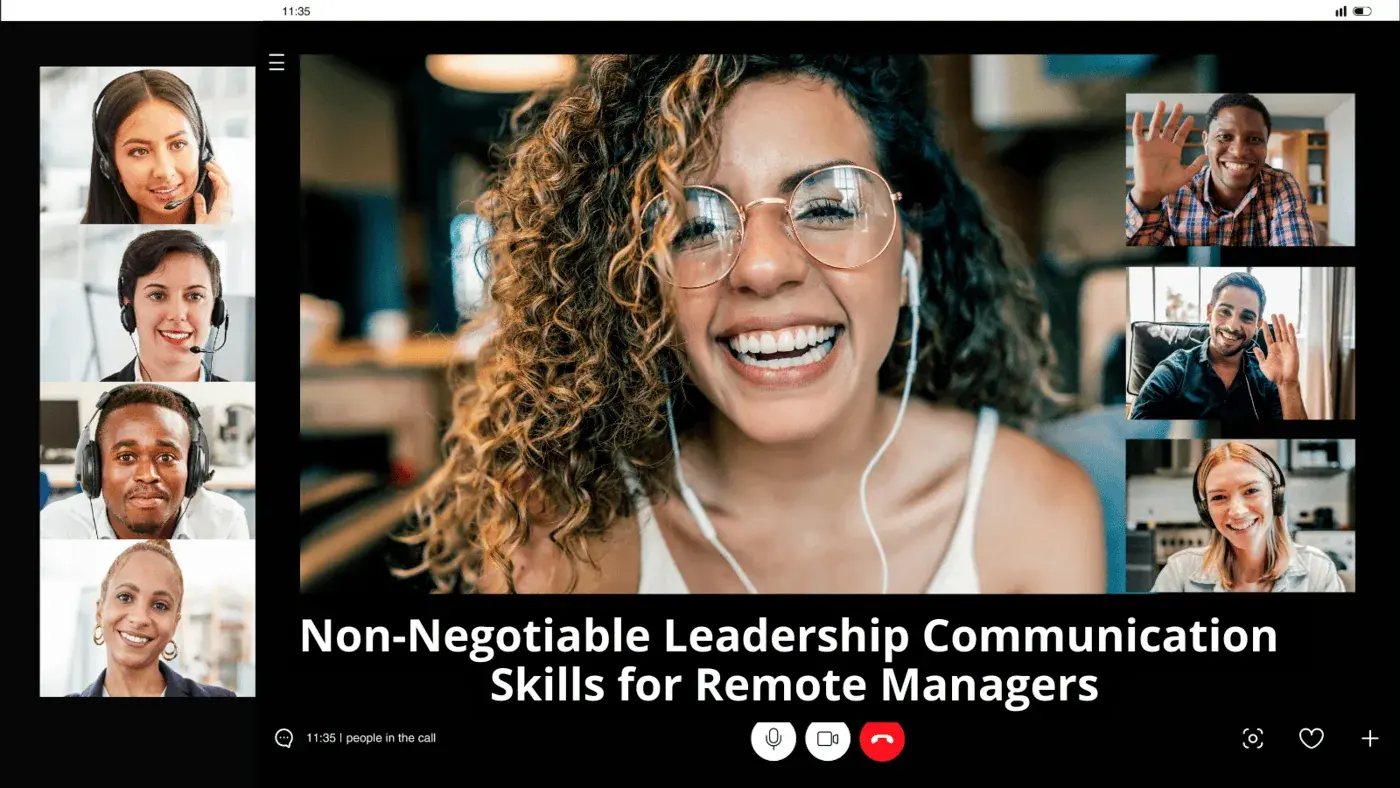7 Leadership Communication Skills for Managing a Remote Team
By Gaurav Sharma, founder and CEO of Attrock, a results-driven digital marketing company he grew an agency from 5-figure to 7-figure revenue in just...

As the saying goes, “teamwork makes the dream work.” But what if your team development is lagging and your team is struggling to achieve or feels unmotivated to succeed? It can be difficult to get members of your team on the same page to work cohesively, which can erode trust over time.
A successful organization is built on the success of its employees, so you as a leader must be aware of how to both support and develop your team to lead them on a path to success. If you are unsure of where to begin are 5 ways to develop your team.
Between what you want for your organization, team, and employees as individuals, setting goals can help create a virtuous cycle where everyone is moving in the same direction. Finding ways to define and design a pathway toward growth and success can help to ensure everyone on your team is set up to reach their full potential. When setting goals, keep in mind that they should be measurable, with specific and achievable objectives and timeframes.
An excellent way to establish goals is by using the SMART method. Goals curated within this method are specific, measurable, achievable, relevant, and timely. Using this method allows you and your team to create actionable solutions. To be more specific you can begin by breaking down a goal that aligns with your strategy and ask yourself the following questions:
In terms of measurability, you want to make sure that you are able to track how much the goal is going to achieve, potential success and failures, as well as how to know exactly when your goal has been reached. When thinking about achievability, you want to think about if you have the resources and if the ends outweigh the means. A proper goal should also be relevant to the work at hand, as well as be time-bound with a start and end date. This will allow you to hold both yourself and your team accountable.
Also, remind yourself and your team to not be afraid of failure. A large part of a successful journey is making mistakes and learning from them to better your future outcomes. Be mindful of this for yourself and as you continue to work with your team.
A role is defined as one’s position on a team and responsibilities are the tasks or duties required of a role. Your team cannot be successful if they do not know what is expected of them, so having these two concepts clearly defined and presented is crucial. In doing so, you will find that you and your team will experience a handful of benefits and minimal confusion.
Increased productivity and morale are just a few results that come with properly detailed roles and responsibilities. Ways you promote this is by determining what needs to be done, finding strengths and weaknesses, referring back to job descriptions, utilizing HR, and holding feedback sessions. Utilizing these tactics can help answer questions. Providing various resources for your employees to have a complete understanding of their job and tasks will help them to be successful.
In addition, make sure you are having regular 1:1 meetings with each of your direct reports.

Give the quiet ones a voice." — Jony Ive
Create a Culture of Listening
Be Clear In Your Own Mind
Create a safe space to nurture new ideas.
Be Clear To Others
Make thoughts/ideas drop-dead easy for others to comprehend.

You don't have to be in every debate but you have to make sure they happen and that there is a culture of debate on your teams. Debating takes time and requires emotional energy but lack of debate saps a team of more time and emotional energy in the long run.
How to debate without grinding everyone down:
Push decisions into the facts, or pull the facts into the decisions, but keep ego out (especially your own).
You're Not the Decider (usually)
The Decider Should Get Facts, Not Recommendations
Go Spelunking
PERSUADE
Emotion. Credibility. Logic." — Aristotle
Minimize the collaboration tax.
How to get the balance right:
Consistency is the hobgoblin of little minds." — Emerson
It should come as no surprise that with a diverse workforce comes many benefits. Acknowledging the differences throughout your organization can help you to develop and lead them better toward a path to success. With diversity comes benefits of increased productivity and creativity, innovation, and a variety of perspectives, as well as lead to a strong company culture and sense of camaraderie between employees.
On the topic of diversity—specifically people of color in the workplace — businessman and CEO Robert F. Smith says, “Representation matters.” It is important to create a work environment that not only feels inclusive but provides your employees with individuals they can relate to and look up to.
Throughout many interviews, Smith emphasizes the importance of taking the time to educate yourself as well as acknowledge your employee' cultural and personal needs. This will not only show that you care about your employee’s wellbeing but also provide an opportunity for them to feel more comfortable within their career and confide in you as their leader.

Effective communication is crucial both in and out of the workplace. To ensure your organization has proper communication, there are seven C’s you need to actively keep in mind and practice: concise, complete, coherent, clear, courteous, concrete, and correct.
To be concise, you want to ensure that you are speaking directly without omitting important information as this will prevent confusion in the future. Complete communication refers to your delivery so that your audience interprets and understands your message the way you intended it. Coherent communication is in regard to the structure of your message so that your ideas flow in a way that makes sense. Tailoring your message to your audience is crucial for a successful understanding. A clear message goes without unnecessary vocabulary and demands your listener's attention.
Courteous communication incorporates eye contact, a respectful and conversational tone, as well as an appreciation for your listener's time and attention. You should be sure that you are actively listening to your audience when they are responding or asking questions, as this will make the communication flow both ways. Concrete and correct communication refers to the vocabulary, grammar, and facts you include within your message. Taking the time to note what you are saying is applicable and appropriate to your audience makes a difference.
Another important aspect of effective communication is the feedback process. Giving feedback to your team in a way that is kind, clear, specific, and sincere provides a clear outline of what they are excelling at versus skills they can work on building. Doing so can also show that you care and are invested in your team's success in a way that gives your team an outlet to learn and grow.
The atomic building block of Radical Candor is the two-minute impromptu development conversation. The motivation to solicit guidance and to act on it is the desire to improve, to grow, to do good work and then make it better, to build strong relationships, and then make them stronger.
You can have these conversations in between meetings. If you’re remote, use tools like Slack to ask someone if they have two minutes to talk.
By keeping these tips in mind, you will be able to not only improve your team but also your skills as a leader. Taking the time to develop your employees will prove to be beneficial to each of them individually as well as your organization as a whole.
*This guest blog post was contributed by a reader.
————————————————————————————————————————————————————————————–
Sign up for our Radical Candor email newsletter >>
Need help practicing Radical Candor? Then you need The Feedback Loop (think Groundhog Day meets The Office), a 5-episode workplace comedy series starring David Alan Grier that brings to life Radical Candor’s simple framework for navigating candid conversations.
You’ll get an hour of hilarious content about a team whose feedback fails are costing them business; improv-inspired exercises to teach everyone the skills they need to work better together, and after-episode action plans you can put into practice immediately to up your helpful feedback EQ.
We’re offering Radical Candor readers 10% off the self-paced e-course. Follow this link and enter the promo code FEEDBACK at checkout.

By Gaurav Sharma, founder and CEO of Attrock, a results-driven digital marketing company he grew an agency from 5-figure to 7-figure revenue in just...

By Gaurav Sharma, founder and CEO of Attrock, a results-driven digital marketing company that he grew an agency from 5-figure to 7-figure revenue in...

By Paul Fayad, co-founder of ELM Learning and Positive Leader. Paul has extensively implemented Radical Candor principles both within his company and...